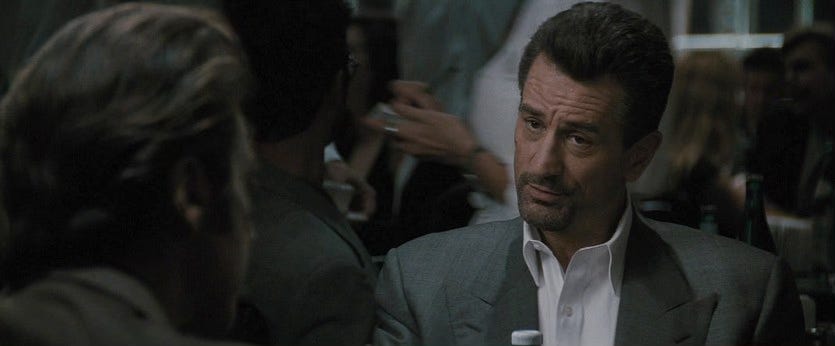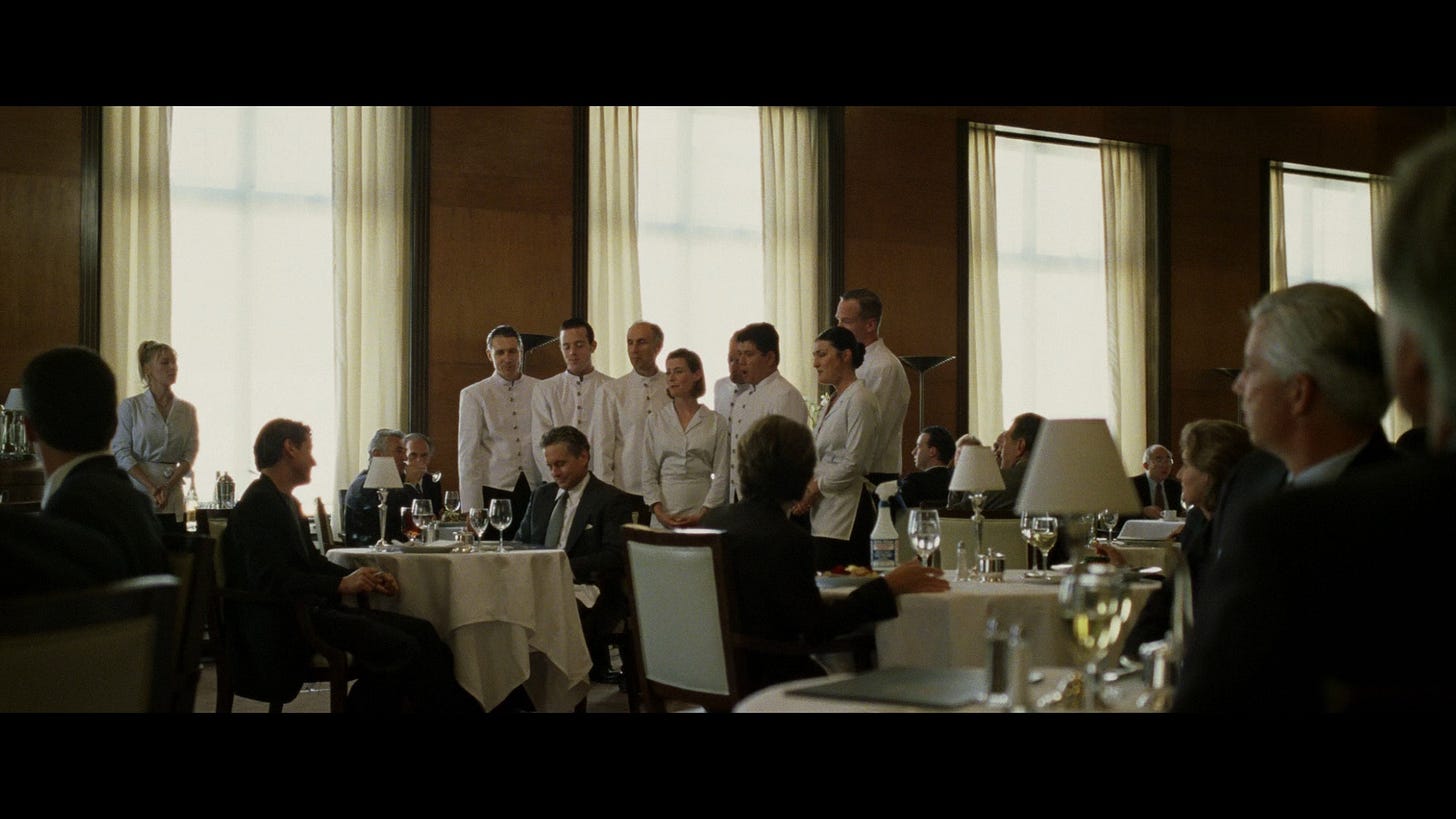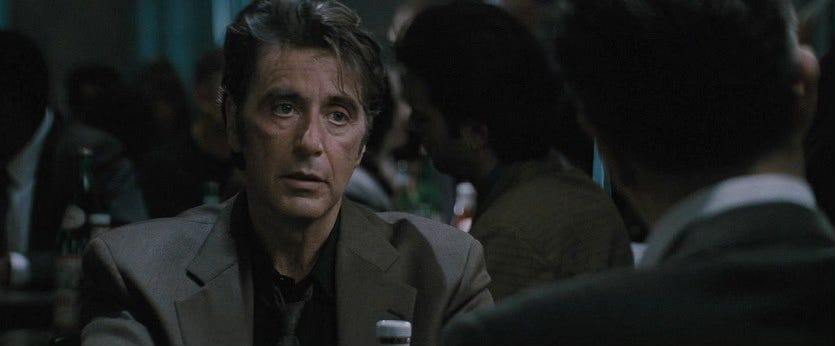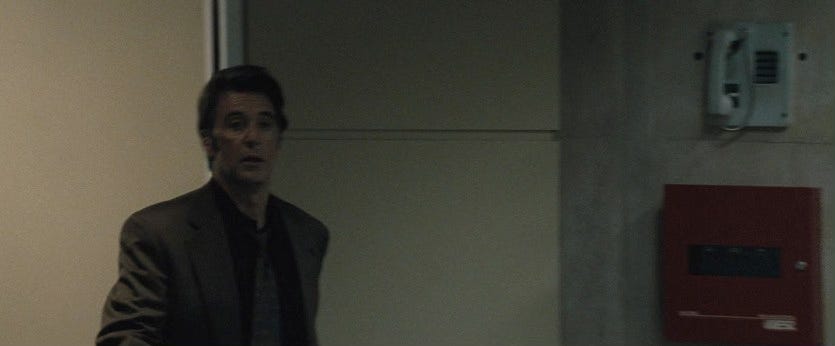Why Does Editing Work?
It's far stranger than it seems
Welcome to the 24 new subscribers (Roughians?) who’ve joined since my last essay. If you missed it, I'm biased, but I think it's a good'un: How the New Hollywood Died.Have you ever thought about how strange film editing is?
No, I hadn’t either. But after reading Apocalypse Now editor Walter Murch’s In the Blink of an Eye, I can’t stop thinking about it.
Let’s consider what editing ultimately is: the splicing together of different shots.
Sometimes, the connection between these shots is obvious. Take, for example, the diner scene from Heat (1995). We first see the scene over the shoulder of Al Pacino’s *definitely not coked-up* detective Vincent Hanna:

We then cut to the ‘reverse shot,’ showing the conversation from Robert De Niro’s ice-cool thief and metal-lover Neil McCauley’s perspective:
We’re not being asked to make any major conceptual leaps here. The two perspectives are clearly connected — they occur (nearly) simultaneously, in the same place, and they share the same context: a conversation between our two protagonists.
You could show this scene without sound to someone who has never watched a film or TV show before, and they would intuitively understand that we’re seeing the same conversation from two different perspectives.
But already, if you pause to think about it, this is a little weird. Outside of film/TV, have you ever experienced a context shift like this? Have you ever suddenly experienced a conversation from the other person’s point of view?
We’ll come back to this. First, let’s make things a little more complicated.
We may, for example, switch to another perspective of the conversation, perhaps showing the entire scene from a distance, like this shot of Michael Douglas’ Nicholas Van Orton and Sean Penn’s Conrad Van Orton in The Game (1997):

Wait — so now we’re outside the conversation. We’re watching from a third, seemingly more objective perspective.
Again, this is stranger than it first seems. Short of a mescaline-induced out-of-body experience, sudden shifts into disembodied perspectives like this aren’t a routine function of our reality.
But it’s still legible. Even though our perspective has shifted, we remain in the same place, time, and context. We can still intuitively comprehend what’s happening.
But then things get really weird. Let’s return to Heat (in many ways, the defining sentence of my 20s). We’ve been watching Neil and Vincent spar/flirt for a few minutes. We sense the conversation coming to an end. “Maybe we’ll never see each other again,” says Neil. The camera lingers on Vincent’s face.
And then we cut:
Woah! Where are we now?!
We have changed location and (presumably) fast-forwarded in time. We have experienced, in Murch’s words, “a total and instantaneous displacement of one field of vision with another.”
So familiar are we now with the visual language of film that the violence of this process, of being ripped from one perspective into another, doesn’t even register. It feels normal. Mundane, even.
But here’s the kicker: until around 130 years ago, no human in history had ever experienced such a perspective shift.
Sure, for thousands of years, we’ve been able to close our eyes and imagine different perspectives. A British soldier fighting in the Somme in the early days of film editing could close his eyes as Mauser bullets rattled over his head and imagine he was sitting by his Newcastle fireplace, enjoying a glass of ale. But as soon as he opened his eyes, he would still see the same blood-soaked battlefield stretched before him.
Likewise, someone watching the first performance of Shakespeare’s The Tempest in 1611 could have been so entranced that they momentarily believed they were with Prospero on the enchanted island. But again, what they saw with their eyes would have remained stubbornly, persistently continuous (says Murch: “stage machinery can only move so fast, after all”).
Until film editing arrived at the turn of the 20th century, thousands of years of evolution had kept our visual perception time-bound and earth-bound. All we could see was what was in front of us; the only perspective we could see it from was our own.
And yet, editing works. Somehow, this strange, inhuman practice felt and continues to feel entirely natural. “We chop up the poor film in a miniature guillotine and then stick the dismembered pieces together like Dr. Frankenstein’s monster,” writes Murch. “The difference (the miraculous difference) is that out of this apparent butchery our creation can sometimes gain not only a life but a soul as well. It is all the more amazing because the instantaneous displacement achieved by the cut is not anything that we experience in ordinary life.”
So naturally have we taken to editing that we rarely even notice it. In fact, when we do, it’s usually because it doesn’t work. Take this hilariously disastrous scene from Taken 3 (2014) (honestly, it gets funnier every time you watch it). Notice how disorientating the cuts are and how frequently they occur. It’s nearly impossible to follow what’s going on at any given moment, and the continuity feels fragmented and out of whack:
(There are more great examples of bad editing in this Reddit thread).
The success of film editing paved the way for cinema and, later, television to be the defining media of the 20th century. It liberated filmmakers from the conventions of theatre. No longer were movies filmed plays. Instead, they could be constructed like magpie’s nests from broken-up, non-sequential fragments and woven together to tell vast stories unconstrained by time or geography.
So, why does editing work? Why don’t our puny human brains shut down at this strange discombobulation of our perception?
Here’s where Murch gets really interesting.
There are, he argues, two elements of our everyday lives where we do experience context shifts akin to a cut in a movie.
I just looked up from my laptop to two people sitting silently opposite each other on the other side of the coffee shop. She is tapping away on an enormous-looking tablet. He looks rather bored. As my eyes travelled from my laptop to their table, I blinked. Yet I didn’t double-take at this brief moment of discontinuity. I didn’t even notice it. I experienced the transition as one uniform process.
On average, we blink 14 to 17 times a minute. Our vision, which we experience as one continuous unbroken take, is actually subdivided, like a movie, into multiple smaller scenes cut together by our blinks.
These cuts, says Murch, aren’t always random. Instead, both when and how often we blink is geared “to our emotional state and to the nature and frequency of our thoughts.” He continues: “Start a conversation with somebody and watch when they blink. I believe you will find that your listener will blink at the precise moment he or she “gets” the idea of what you are saying, not an instant earlier or later.”
Blinks, Murch suggests, are punctuation marks used to separate ideas. Just like how you would have stopped reading this essay if I didn’t include any commas or full stops, so blinks help us make sense of reality.
A cut in a movie performs the same function. “A shot presents us with an idea, or a sequence of ideas,” writes Murch. “The cut is a 'blink’ that separates and punctuates those ideas. At the moment you decide to cut, what you are saying is, in effect, ‘I am going to bring this idea to an end and start something new.’”
According to Murch, we’re all editors of reality, stitching our worlds together with our blinks. It follows that editing works not despite our evolution but because of it. Cuts in a movie tap into not just our psychology, but our biology.
Cool, right? Well, Murch’s second theory is even cooler.
Can you think of the other circumstance in which we experience reality in a discontinuous, pieced-together way?
Here’s a clue:
The answer, of course, is when we dream.
The connection between dreaming and editing is twofold. Going to sleep could be analogous to a cut in a movie: when we wake up, both the time and the context have shifted. We’re still in the same place (or at least, we should be), but maybe there is dawnlight seeping through the curtains, the cat has left the foot of the bed, or the humming silence of night has been replaced by the crowing of a rooster.
But what Murch is truly interested in is what happens while we’re asleep.
Think of the last time you dreamed. Try to piece together the sequence of events. Chances are, you remember hazy, disconnected images whose connection to one another may make intuitive sense but little more.
Murch argues that the disjointed, fragmented, abrupt nature of dreaming is analogous to how shots are cut together in a film. He hints at a symbiotic link between dream and cinema: film as a waking dream, dream as a sleeping film.
“In the darkness of the theater, we say to ourselves, in effect, ‘This looks like reality but it cannot be reality because it is so visually discontinuous, therefore, it must be a dream.’”
There’s a hypnotic, semi-awake quality to being entranced by a film. Perhaps this speaks to the sanctity of the theatrical experience, now challenged by the distraction-ridden age of home streaming. Perhaps this is what we’re missing in our era of plot-hole-punditry and movie breakdowns. We are using the cold language of wakefulness to dissect an art form that relies on a hazy, symbolic, intuitive language — one that was once the stalking ground of sleep.
Here lies the great paradox of editing.
There is something so profoundly weird about its ability to teleport us between perspectives, something that we had not once achieved over hundreds of thousands of years of evolution.
And yet this same process of evolution had been quietly, subtly preparing us for its arrival all along.
In the end, cinema’s most unnatural quality may also be what makes it feel so human.
If you enjoyed reading and would like to support my work, please consider buying me a ‘coffee…’
If you didn’t enjoy it - what are you still doing here!





A cool and informative piece. I'm definitely picking up Murch's book soon.